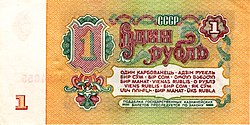| Revision as of 11:12, 25 September 2004 editSpiff~enwiki (talk | contribs)Extended confirmed users930 editsm no need for small-tags in image text← Previous edit | Revision as of 21:18, 6 October 2004 edit undoA2Kafir (talk | contribs)Extended confirmed users, Pending changes reviewers14,026 editsmNo edit summaryNext edit → | ||
| Line 11: | Line 11: | ||
| The word kopek/''kopeyka'' derives from the russian ''kop'yo'' (копьё) – a spear. The first kopek coins carried the ] coat of arms with ] slaying a dragon with a spear. | The word kopek/''kopeyka'' derives from the russian ''kop'yo'' (копьё) – a spear. The first kopek coins carried the ] coat of arms with ] slaying a dragon with a spear. | ||
| Over time the amount of precious metal in a ruble varied. In a ] currency reform ] standardized the ruble coin to 28 grams of ]. While ruble coins were mostly silver, sometimes they were minted of gold, and some ] coins were ]. The '''gold ruble''' introduced in ] was equal to 0.774235 g of gold. The Soviet ruble of ] was formally equal to 0.987412 g of ], but the exchange for gold was never available to general public. Rubles are no longer linked to a gold standard. | Over time the amount of precious metal in a ruble varied. In a ] currency reform ] standardized the ruble coin to 28 grams of ]. While ruble coins were mostly silver, sometimes they were minted of gold, and some ] coins were ]. The '''gold ruble''' introduced in ] was equal to 0.774235 g of gold. The Soviet ruble of ] was formally equal to 0.987412 g of ], but the exchange for gold was never available to the general public. Rubles are no longer linked to a gold standard. | ||
| Ten ruble coins are sometimes informally named '''chervonets''' (''черво́нец''). Formerly it was a 3-ruble gold coin and later a 10-ruble bill. | Ten ruble coins are sometimes informally named '''chervonets''' (''черво́нец''). Formerly it was a 3-ruble gold coin and later a 10-ruble bill. | ||
Revision as of 21:18, 6 October 2004

The ruble (Russian рубль, French-derived transliteration rouble) is the currency of the Russian Federation (and formerly, of the Soviet Union and the Russian Empire). One ruble is divided into 100 kopeks (копе́йка). The ISO 4217 currency code for the ruble is now RUB; the former code, RUR, referres to the currency prior to 1997 denomination.
In Russian, a folk name for "ruble", tselkovyi (wholesome), is known, which is a shortening of the "tselkovyi ruble", i.e. a wholesome, uncut ruble. A practice of cutting precious metal coins was historically wide-spread throughout the world. A small chunk was cut from a coin by its current holder before the coin was tendered at the full value. Over a period the coins had become obviously smaller, but legally still carried the full face value. Thus wholesome adjective was needed to distinguish the uncut coins.
The ruble has been the Russian unit of currency for many centuries. The word "ruble" is derived from the Russian verb рубить, rubit, i.e., to chop. Historically, "ruble" was a piece of a certain weight chopped off a silver ingot (grivna), hence the name.
The word kopek/kopeyka derives from the russian kop'yo (копьё) – a spear. The first kopek coins carried the Moscow coat of arms with Saint George slaying a dragon with a spear.
Over time the amount of precious metal in a ruble varied. In a 1704 currency reform Peter I standardized the ruble coin to 28 grams of silver. While ruble coins were mostly silver, sometimes they were minted of gold, and some 19th century coins were platinum. The gold ruble introduced in 1897 was equal to 0.774235 g of gold. The Soviet ruble of 1961 was formally equal to 0.987412 g of gold, but the exchange for gold was never available to the general public. Rubles are no longer linked to a gold standard.
Ten ruble coins are sometimes informally named chervonets (черво́нец). Formerly it was a 3-ruble gold coin and later a 10-ruble bill.
All Russian paper money is currently printed at the state-owned factory Goznak in Moscow, which was organized on June 6, 1919 and has continued to operate ever since. Coins are minted in the Monetny Dvor mint in St. Petersburg that operates since 1724 and in Moscow.
Ruble in Russian/Soviet subdivisions


In the Soviet period, the ruble had it own name in official languages of the Soviet Union. The value of all banknotes had the value printed in the languages of all Soviet Republics. This naming is preserved in modern Russia. Example: Tatar for ruble is sum. The current names of several currencies of Central Asia are simply the local names for ruble.
The name of the currency in the official languages of the 15 republics:
- Russian: рубль
- Ukrainian: карбованец
- Belarusian: рубель
- Uzbek: сўм
- Kazakh: сом
- Georgian: მანეთი
- Azerbaijani: манат
- Lithuanian: rublis
- Moldavian: рублэ
- Latvian: rublis
- Kyrgyz: сом
- Tajik: сўм
- Armenian: ռուբլի
- Turkmen: манат
- Estonian: rubla